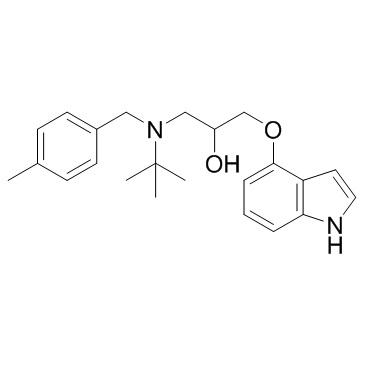| Description |
SR-18292 is a PPAR gamma coactivator-1α (PGC-1α) inhibitor, which increases PGC-1α acetylation, suppresses gluconeogenic gene expression and reduces glucose production in hepatocytes.
|
| Related Catalog |
|
| Target |
PGC-1α[1]
|
| In Vitro |
The transcriptional coactivator PGC-1α plays a pivotal role in energy homeostasis by co-activating transcription factors that regulate fat and glucose metabolism. SR-18292 increases the interaction of PGC-1α with the acetyl transferase GCN5 and reduces co-activation of nuclear hormone receptor HNF4α by PGC-1α. SR-18292 suppresses HNF4α/PGC-1α gluconeogenic transcriptional function. By increasing the interaction of GCN5 with PGC-1α, SR-18292 increases the acetylation of specific PGC-1α lysine residues that might subsequently decrease its gluconeogenic activity[1].
|
| In Vivo |
SR-18292 reduces fasting blood glucose, increases hepatic insulin sensitivity and improves glucose homeostasis in diabetic mice. The high fat diet (HFD) fed mice, a dietary model of obesity and T2D, are treated with SR-18292 (45mg/kg) via I.P. injection for 3 consecutive days and again on day 4 before measuring fasting blood glucose. Strikingly, mice that are treated with SR-18292 have significantly lower levels of fasting blood glucose concentrations compared to matched vehicle-treated control mice. The induction of gluconeogenic gene expression is a regulatory component of the response to fasting. Importantly, gluconeogenic gene expression, specifically that of Pck1, is inhibited in livers isolated from mice treated with SR-18292[1].
|
| Kinase Assay |
For determination of GCN5 HAT activity U-2 OS cells overexpressing Ad-GCN5 are treated with SR-18292 (10 μM) for 18 h. Cells are lysed with buffer B (20 mM HEPES-KOH (pH 7.9), 125 mM NaCl, 1 mM EDTA, 1 mM DTT, 1% IGEPAL (v/v), 10% glycerol (v/v), 5 mM NaF, 5 mM β-glycerophosphate, 5 mM sodium butyrate and 10 mM nicotinamide), supplemented with Protease Inhibitor Cocktail. FLAG-GCN5 is immunoprecipitated with FLAG beads overnight at 4°C following multiple washes with lysis buffer. GCN5 is then eluted using 3× FLAG peptide and the purified protein is used to determine HAT activity using the HAT Inhibitor Screening Assay Kit[1].
|
| Cell Assay |
For cell viability determination using MTT, primary hepatocytes are seeded on a 96-well plate at 20,000 cells/well. The following day cells are treated at different doses, as indicated, for 18 h treatment of primary hepatocytes. 5 μL of MTT reagent (5 mg/mL) is then added to each well (n=4/dose) and cells are incubated for 1h at 37°C. Medium is discarded and dye is extracted by adding 100 μL DMSO to each well. For cytotoxicity determination using ToxiLight Non-destructive Cytotoxicity Bioassay, hepatocytes are seeded on a 6-well plate and treated with either SR-18292 (20 μM) or Cisplatin (50 μM) for 18 h. 50 μL of medium is collected and used to measure cellular toxicity by adding 100 of adenylate kinase detection reagent and incubating 5 min at RT before measuring luminescence[1].
|
| Animal Admin |
Mice[1] For in vivo studies with DIO mice, males 6-8 weeks old are fed high fat diet (HFD) for the indicated time. For drug administration, SR-18292 (45 mg/kg) is injected via I.P. for 3 days between 4-5 pm and food is removed on day 3 at 5pm. The following morning (day 4) SR-18292 is injected again (for a total of 4 injections) and blood glucose is measured after 3 hours. Injection volume does not exceed 275 μL per mouse[1].
|
| References |
[1]. Sharabi K, et al. Selective Chemical Inhibition of PGC-1α Gluconeogenic Activity Ameliorates Type 2 Diabetes. Cell. 2017 Mar 23;169(1):148-160.e15.
|
